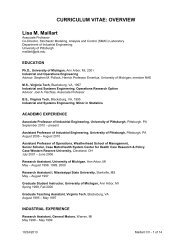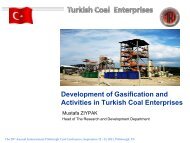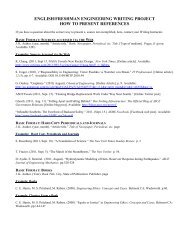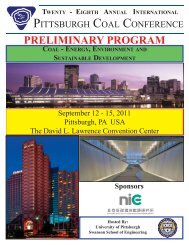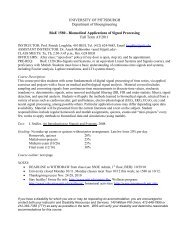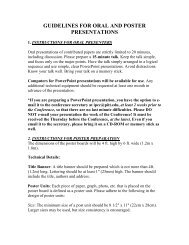Abstract Booklet 2006 - Swanson School of Engineering - University ...
Abstract Booklet 2006 - Swanson School of Engineering - University ...
Abstract Booklet 2006 - Swanson School of Engineering - University ...
Create successful ePaper yourself
Turn your PDF publications into a flip-book with our unique Google optimized e-Paper software.
Heat-exchangers, particle filters, turbines, and other components in integrated coal<br />
gasification combined cycle system must withstand the highly sulfiding conditions <strong>of</strong> the<br />
high-temperature coal gas over an extended period <strong>of</strong> time. The performance <strong>of</strong> components<br />
degrades significantly with time unless expensive high alloy materials are used. Deposition<br />
<strong>of</strong> a suitable coating on a low-cost alloy may improve its resistance to such sulfidation<br />
attack, and decrease capital and operating costs. The alloys used in the gasifier service<br />
include austenitic and ferritic stainless steels, nickel-chromium-iron alloys, and expensive<br />
nickel-cobalt alloys such as Inconel, Hastelloy and Haynes alloys. Not only are these<br />
materials expensive, their machining is also difficult, which makes fabrication <strong>of</strong><br />
components particularly costly.<br />
SG Solution's coal gasification power plant in Terre Haute, IN, uses ConocoPhillips' E-Gas<br />
technology. The need for corrosion-resistant coatings exists in two areas: (1) the tube sheet<br />
<strong>of</strong> a heat exchanger at ~1000°C that is immediately downstream <strong>of</strong> the gasifier, and (2)<br />
porous metal particulate filter at 370°C, which is downstream <strong>of</strong> the heat exchanger. These<br />
components operate at gas streams containing as much as 2% H 2 S. This corrosion is the<br />
leading cause <strong>of</strong> the unscheduled downtime at the plant and hence success in this project will<br />
directly impact the plant availability and its operating costs. Coatings that are successfully<br />
developed for this application will find use in similar situation in other coal-fired power<br />
plants. A protective metal or ceramic coating that can resist sulfidation corrosion will extend<br />
the life-time <strong>of</strong> these components and reduce maintenance.<br />
SRI has developed a low-cost fluidized-bed-reactor chemical vapor deposition (FBR-CVD)<br />
technology to deposit coatings <strong>of</strong> various metals including Cr, Si, Ti, Al, B, Ni, W, and Mo<br />
on metals and ceramics. SRI s method for depositing corrosion-resistant coatings also has<br />
advantages over the commonly used techniques such as thermal or plasma spraying, which<br />
produce coatings with internal porosity and microcracks, so that they must be thick to<br />
prevent gas penetration to the substrate. The FBR-CVD technology allows (1) both internal<br />
and external surfaces to be coated, (2) diffusion bonding to the substrate, and (3) formation<br />
<strong>of</strong> a dense layer on the surface and increased corrosion protection <strong>of</strong> the substrate.<br />
We have successfully deposited coatings <strong>of</strong> Cr, Cr-Al, Ti, Ti-Al nitrides, and Si-Al nitrides<br />
on various steel samples, and tested them in simulated gasifier environments. Coatings on<br />
low carbon steels in the 400 series was most effective as these samples showed minimal<br />
corrosion under conditions where Inconel and other coated samples were badly corroded.<br />
Ferritic steels appear to be more suitable for diffusion barrier coatings than steels containing<br />
Ni. Some <strong>of</strong> the coated samples have been placed in the SG Solutions gasifier plant in Terre<br />
Haute, IN, and we await their retrieval at the next scheduled maintenance.<br />
39-2<br />
Oxidation <strong>of</strong> Alloys for Advanced Steam Turbines<br />
Gordon Holcomb, Malgorzata Ziomek-Moroz, David E. Alman, NETL, USA<br />
Ultra supercritical (USC) power plants <strong>of</strong>fer the promise <strong>of</strong> higher efficiencies and<br />
lower emissions. Current goals <strong>of</strong> the U.S. Department <strong>of</strong> Energy s Advanced Power<br />
Systems Initiatives include power generation from coal at 60% efficiency, which<br />
requires steam temperatures <strong>of</strong> up to 760°C. This research examines the steam<br />
oxidation <strong>of</strong> alloys for use in USC systems, with emphasis placed on applications in<br />
high- and intermediate-pressure turbines.<br />
39-3<br />
Experimental Evaluation for Fireside Corrosion Resistance <strong>of</strong> Advanced<br />
Materials for Ultra-Supercritical Coal-Fired Power Plants<br />
Horst Hack, Greg Stanko, Foster Wheeler North America Corp, USA<br />
The U.S. Department <strong>of</strong> Energy (DOE) and the Ohio Coal Development Office (OCDO) are<br />
co-sponsoring a project, managed by Energy Industries <strong>of</strong> Ohio (EIO), to evaluate candidate<br />
materials for coal-fired boilers operating under ultra-supercritical (USC) steam conditions.<br />
Power plants incorporating USC technology will deliver higher cycle efficiency, and lower<br />
emissions <strong>of</strong> carbon dioxide (CO 2 ) and other pollutants than current coal-fired plants.<br />
Turbine throttle steam conditions for USC boilers approach 732°C (1350°F), at 35 MPa<br />
(5000 psi). The materials used in current boilers typically operate at temperatures below<br />
600°C (1112°F) and do not have the high-temperature strength and corrosion properties<br />
required for USC operation. Materials that can meet the high temperature strength and<br />
corrosion requirements for the waterwalls and superheater/reheater sections <strong>of</strong> USC boilers<br />
need to be tested and evaluated.<br />
The focus <strong>of</strong> the current work is experimental evaluation <strong>of</strong> fireside corrosion resistance <strong>of</strong><br />
candidate materials for use in USC boilers. These materials include high-strength ferritic<br />
steels (SAVE12, P92, HCM12A), austenitic stainless steels (Super304H, 347HFG, HR3C),<br />
and high-nickel alloys (Haynes® 230, CCA617, INCONEL® 740, HR6W). Protective<br />
coatings (weld overlays, diffusion coatings, laser claddings) that may be required to mitigate<br />
corrosion were also evaluated. Corrosion resistance was evaluated under synthesized coalash<br />
and flue gas conditions typical <strong>of</strong> three North American coals, representing Eastern<br />
(mid-sulfur bituminous), Mid-western (high-sulfur bituminous), and Western (low-sulfur<br />
sub-bituminous) coal types. Laboratory testing for waterwall materials was performed at<br />
455°C (850°F), 525°C (975°F), and 595°C (1100°F). The superheat/reheat materials were<br />
exposed to 650°C (1200°F), 705°C (1300°F), 760°C (1400°F), 815°C (1500°F), and 870°C<br />
(1600°F). Samples were exposed for 1000 hours, with ash being replenished every 100<br />
hours to maintain aggressive conditions. Samples were evaluated for thickness loss and<br />
subsurface penetration <strong>of</strong> the corrosive species. The laboratory testing was useful for<br />
screening different alloys in controlled environments, where the different variables <strong>of</strong> alloy<br />
content, temperature, fuel/ash and sulfur in the flue gas could be evaluated.<br />
35<br />
Promising materials from the laboratory tests were assembled on corrosion probes for testing<br />
in three utility boilers. Air-cooled, retractable corrosion probes were designed to maintain<br />
metal temperatures using multiple zones, representing USC superheat/reheat temperatures,<br />
ranging from 650°C (1200°F) to 870°C (1600°F). The probes were installed in utility<br />
boilers, equipped with low NO x burners, representing each <strong>of</strong> the three coal types. This paper<br />
presents an update on the current status <strong>of</strong> this ongoing fireside corrosion advanced materials<br />
research program.<br />
39-4<br />
Carbon Molecular Sieve Membrane/Module and its Use for<br />
Hydrogen Production for Coal<br />
Paul Liu, Richard Ciora, Media & Process Technology, Inc., USA<br />
Theodore Tsotsis, <strong>University</strong> <strong>of</strong> Southern California, USA<br />
Carbon, due to its inertness, is considered an ideal material candidate for handling<br />
coal-related process streams. Although carbon molecular sieve (CMS) materials have<br />
been used extensively in industry as adsorbents, they have not moved beyond the<br />
academic novelty stage as a membrane material. Two major application-related<br />
barriers have prevented industrial acceptance <strong>of</strong> a CMS membrane, specifically, (i)<br />
poisoning and/or aging by a wide range <strong>of</strong> contaminants/impurities present in the<br />
atmosphere either during storage or in the stream to be treated and (ii) the lack <strong>of</strong> a<br />
module that is both cost and commercially/industrially acceptable, particularly for a<br />
high temperature and high pressure applications. Media and Process Technology Inc.<br />
has overcome these two barriers by choosing appropriate operating conditions and<br />
developing a CMS/ceramic composite membrane/module. One <strong>of</strong> the major<br />
application focuses for this CMS membrane/module is hydrogen/electricity coproduction<br />
from coal. By operating at an intermediate temperatures, i.e., 150 to 300°C,<br />
our unique CMS membrane/module can function as a simple hydrogen separator or as<br />
a membrane reactor for water gas shift reaction. Hydrogen permeances <strong>of</strong> 1 to<br />
>3 m 3 /m 2 /hr/bar and H 2 /CO selectivities <strong>of</strong> 50 to >100 are typical in this operating<br />
temperature range. Based upon the performance <strong>of</strong> the membrane and the features <strong>of</strong><br />
the module, we have developed several process scenarios for hydrogen production<br />
from coal. Process intensification as a result <strong>of</strong> the use <strong>of</strong> our membrane/module will<br />
be presented.<br />
39-5<br />
FT-IR and XRD Study <strong>of</strong> Tirap Coal<br />
Binoy K. Saikia, R. K. Boruah, P K Gogoi, Tezpur <strong>University</strong>, INDIA<br />
Coal sample from Tirap colliery <strong>of</strong> Assam, India was studied using FTIR and XRD<br />
methods. FTIR study shows the presence <strong>of</strong> aliphatic -CH, -CH 2 and -CH 3 groups,<br />
aliphatic C-O-C stretching associated with -OH and -NH stretching vibrations and<br />
HCC rocking (single and condensed rings). XRD pattern <strong>of</strong> the coal shows that it is<br />
amorphous in nature. Function <strong>of</strong> Radial Distribution Analysis (FRDA) indicates that<br />
coal is lignite in type and there is no evidence <strong>of</strong> graphite like structure. The first<br />
maximum in the FRDA at R = 0.133 nm relates to the C = C bond (Type C – CH = CH<br />
– C), the second maximum at R = 0.25 nm relates to the distance between carbon<br />
atoms <strong>of</strong> aliphatic chains that are located across one carbon atom. The curve intensity<br />
pr<strong>of</strong>iles obtained from FRDA show quite regular molecular packets for this coal.<br />
SESSION 40<br />
ENVIRONMENTAL CONTROL TECHNOLOGIES: MERCURY – 2<br />
40-1<br />
Recent Advances in Trace Metal Capture Using Micro and Nano-Scale Sorbents<br />
Jason D. Monnell, Radisav D. Vidic, <strong>University</strong> <strong>of</strong> Pittsburgh, USA<br />
Dianchen Gang, West Virginia <strong>University</strong> Institute <strong>of</strong> Technology, USA<br />
Andrew Karash, Evan J. Granite, DOE/NETL, USA<br />
The adsorption <strong>of</strong> mercury, arsenic, and selenium on micro and nano-scale sorbents is<br />
reviewed. In particular, efforts on trace metal capture from coal-derived gas streams<br />
using nano-scale sorbents are summarized. A collaborative effort between the<br />
<strong>University</strong> <strong>of</strong> Pittsburgh, WVU Tech, and NETL on the development <strong>of</strong> novel micro<br />
and nano-scale sorbents has been initiated with the preliminary results presented<br />
herein. Future research directions are suggested and an extensive list <strong>of</strong> references is<br />
provided.<br />
40-2<br />
Aqueous Mercury and Lead Removal with Activated Carbons<br />
Derived from High Sulfur Carbonaceous Materials<br />
Shitang Tong, Shuqing Zhang, Xiaoqing Wu, Wuhan <strong>University</strong> <strong>of</strong> Science and<br />
Technology, CHINA<br />
Jenny Cai, Loraine Laiyin Chiu, Donald W. Kirk, Charles Q. Jia, <strong>University</strong> <strong>of</strong><br />
Toronto, CANADA<br />
Hg and Pb are <strong>of</strong> environmental concerns due to their toxic and bioaccumulative<br />
nature. Developing cost effective adsorbents for controlling their emissions to the



